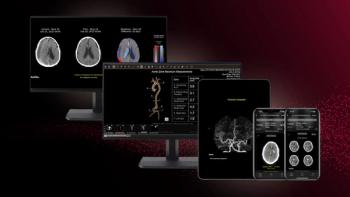
Experts pinpoint benefits of hybrid systems in cancer management
Correct diagnosis of tumor character and stage is fundamental to lung-cancer therapy planning, but evaluating indeterminate solitary pulmonary nodules (SPNs) continues to challenge radiologists. In addition, it is vital to determine as soon as possible whether patients are likely to respond to treatment.
Correct diagnosis of tumor character and stage is fundamental to lung-cancer therapy planning, but evaluating indeterminate solitary pulmonary nodules (SPNs) continues to challenge radiologists. In addition, it is vital to determine as soon as possible whether patients are likely to respond to treatment.
SPNs are common, and a small percentage are malignant. PET/CT is a sensitive detector for malignancy due to FDG uptake. Missed lesions are rare and occur mainly when the lesion is small or the cancer well differentiated, as well differentiated cancer has a low avidity for FDG. False positives may result from FDG uptake due to other reasons, such as infection and inflammation, though the higher the uptake, the greater the risk of cancer, according to Dr. Sally Barrington, a consultant in nuclear medicine at the PET Imaging Centre at St. Thomas' Hospital in London, speaking at Sunday's session on monitoring therapy and follow-up in cancer.
In a study at that hospital of 285 patients, those with a tracer uptake score of 4 (the average uptake score was 1), had a 96% incidence of malignancy.
Lesions can be investigated with flexible bronchoscopy, CT-guided biopsy, or with PET in patients with poor lung function when the risk of pneumothorax needs to be avoided.
"For pulmonary nodules that require tissue diagnosis, where the uptake is very high, it is reasonable to proceed direct to surgery. Using this approach, a few patients will go to the operating theater with benign disease, but the rate is very low," she said.
T-staging may sometimes require CT with intravenous contrast for central tumors or those adjacent to the chest wall, otherwise prognostic information can be obtained from the primary tumor in the PET scan, Barrington said. She noted that PET yielded a high negative predictive value in N-staging. Importantly, negative node findings in PET obviated the need for mediastinoscopy or endoscopic ultrasound.
In positive nodes, sampling techniques vary with node location. A nodule next to the left pulmonary artery might be reported as a T2N1, but uptake in an adjacent lymph node visualized in PET/CT and a lesion in the vertebrae may reveal that the stage is really T2N2M1.
Because PET/CT is a useful tool to detect and stage metastasis in other areas of the body, it can also reduce futile thoracotomy, whereby during surgery, benign disease is discovered to be inoperable.
"I think that (4D PET/CT) respiratory gating will be very important to help us improve detection and targeted radiotherapy. New tracers targeting other aspects of tumor biology will be useful for guiding treatment in individual patients," Barrington said.
Such new drug development will play a major role in the future of perfusion CT to measure response to anti-angiogenic therapy. Because therapy is expensive, clinicians want early and reliable answers as to whether growth-inhibiting drugs are working. New imaging strategies are needed to complement advances in anti-angiogenics and the new molecular approach to therapy, according to Dr. Anno Graser, radiologist at the University Hospital of Munich.
Traditionally, treatment response has been assessed by visualizing tumor size and volume, but in anti-angiogenics these parameters may remain unchanged for weeks after the start of treatment. Moreover, tumor size might not reflect accurate response to treatment, whereby a tumor may shrink while metabolic activity remains the same. Functional imaging, such as perfusion CT, will show additional information to morphology.
"Perfusion multislice CT can easily be integrated into routine staging protocols and will be much faster in determining which patients will respond to therapy and which will not," Graser said.
Newsletter
Stay at the forefront of radiology with the Diagnostic Imaging newsletter, delivering the latest news, clinical insights, and imaging advancements for today’s radiologists.




























